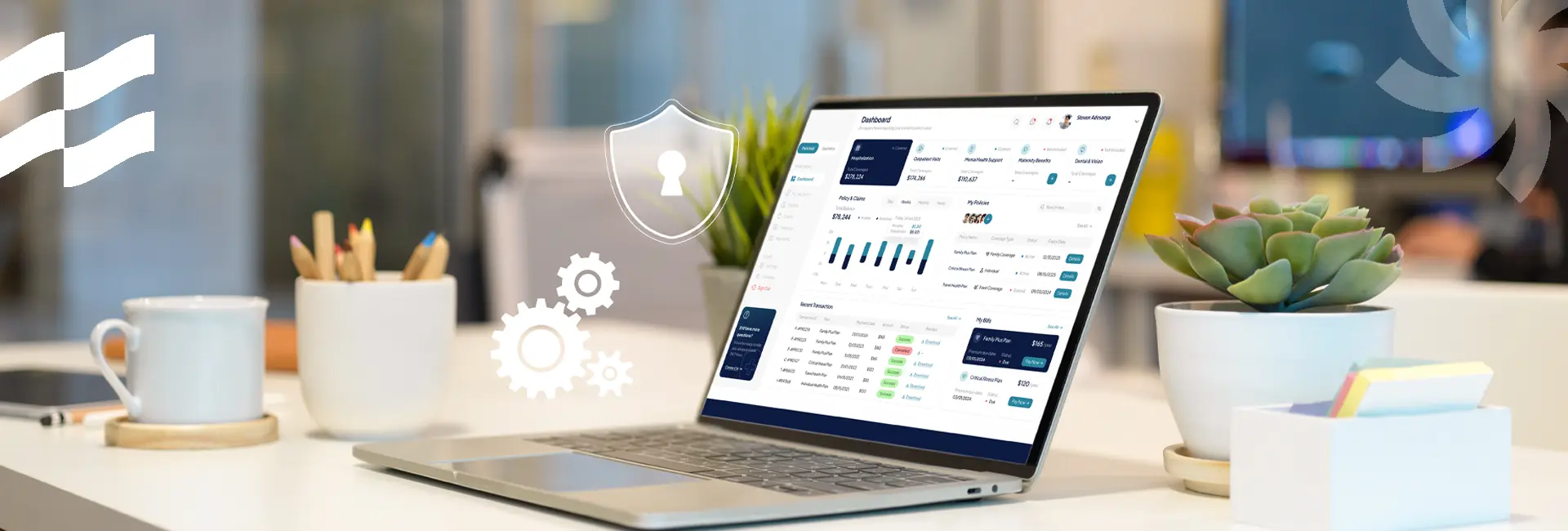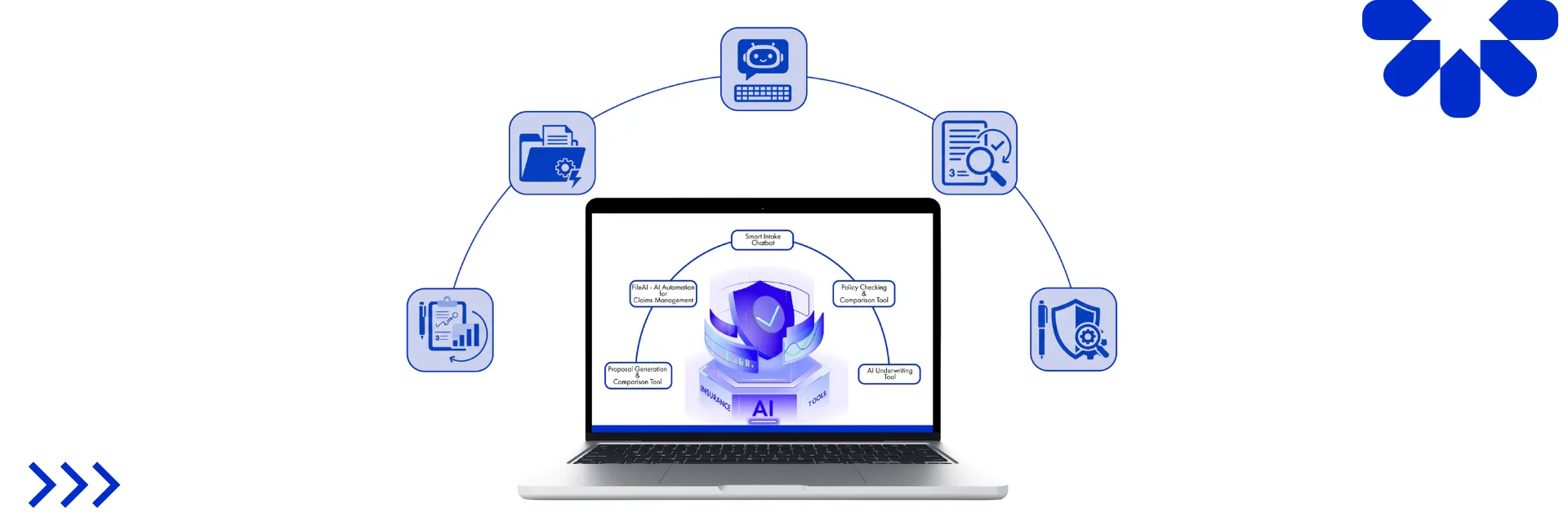Do you know that nearly 80% of insurance executives say their company’s future depends on adapting to digital transformation?
The evolution of P&C insurance digital transformation

Insurers managed everything the hard way for years—stacks of forms, piles of paperwork, and claim processing. Sure, it got the job done back then, but times have changed, and the industry is shifting toward faster, smarter processes, especially since data exploded. And let’s be real: the transition to digital did not occur suddenly. Customers wanting more, rivals stepping up their game, and technology's rapid advancement have all helped propel it forward.
However, following the same old methods is no longer an option. Your clients know that digital solutions are available and need speed and ease.
The rise of AI, Machine Learning (ML), the Internet of Things (IoT), Blockchain, and Robotic Process Automation (RPA) is changing how you do business. Here’s how P&C insurance digital transformation works:
- AI and ML let you quickly analyze massive amounts of data, making underwriting more accurate and spotting fraud faster.
- IoT provides real-time data from connected devices, like smart home sensors or vehicle trackers, offering precise risk insights and lowering claim frequency.
- Blockchain allows safe data exchange, increases transaction transparency, and lowers the chance of fraud.
- RPA has taken over your routine back-office duties, freeing up your team to work on more difficult and valuable projects.
Benefits of digital transformation for P&C insurers
Are manual processes slowing your team down? If yes, you may be finding it difficult to meet client needs for more individualized attention and better claims processing. Outdated P&C technology can make it difficult to compete in the P&C insurance sector, where every second matters. So, are you ready to see how P&C tech can give your business the edge it needs? Let’s explore the benefits.
1. New product opportunities
P&C insurance is rising in response to the challenge as customer needs change quickly. Thanks to P&C insurers for using features like Identity theft protection, ride-sharing insurance, and self-service mobile apps, customers now have more control and peace of mind. It’s not about following every trend but creating products that genuinely solve customers' problems.
You may design unique and customized policies with data-driven insights through Usage-based insurance (UBI). It’s a well-liked choice that modifies auto insurance prices according to an individual's driving habits. UBI is rapidly gaining traction because it is anticipated to cover 20% of American cars within the next three years. This demonstrates how much consumers value paying for the services, and it benefits insurers to satisfy their clients' actual demands.
2. Better risk assessment with telematics
Telematics is changing the game for P&C insurers by reflecting real-time data for advanced risk assessment. For instance, in auto insurance, telematics devices track metrics like speed, braking patterns, and driving times. This data helps you identify safe drivers and adjust premiums accordingly. According to Cisco, this technology has led to an 80% reduction in claims costs. And it’s not just for cars and autos—home insurers now use smart devices to monitor properties, catching issues like water leaks before they turn into expensive problems.
3. Improved customer engagement with AI
AI-driven chatbots and voice assistants are elevating customer interactions in P&C insurance. These tools answer questions, walk users through policy details, and provide quick solutions when issues arise. These tools help meet the expectations of younger generations, with 60% of Millennials and Gen X saying they want fast, on-demand service. Chatbots and AI-driven support make that possible, boosting customer satisfaction and saving your team time.
4. Cost savings through automation
Automating repetitive tasks saves money and reduces mistakes in P&C insurance. For example, P&C insurers can quickly process routine claims, such as minor auto accidents, without requiring manual input, reducing both time and error rates. McKinsey found that digital insurers can cut costs by 15-25% by applying automation in P&C insurance practices like claims processing. With access to real-time data, you can improve underwriting accuracy and spot potential fraud, strengthening your overall risk management.
Now, let’s get into how technology is reshaping specific areas of the industry.
Key areas where P&C technology has made an impact

P&C Insurance has seen several fundamental changes due to digital transformation, which has made procedures quicker, intelligent, and customer-focused. Let's examine the main areas where P&C technology is transforming your company.
1. Underwriting: Smarter risk assessment
Whether for homeowners' or vehicle insurance, traditional underwriting frequently depended on human inspections and historical data, which resulted in broad risk ratings. Thanks to artificial intelligence and data analytics, you may now access real-time information from a variety of sources, including telematics, meteorological data, and property records.
For instance, you can utilize smart home data to monitor a property's condition. Sensors can detect oversights like fire dangers, water leaks, or even abnormally high humidity levels that could indicate mold growth. By analyzing this real-time data, you can reward homeowners who take proactive care of their properties by modifying premiums based on the property's state and hygiene. Similarly, AI can help you assess flood risk by examining satellite images and weather patterns, allowing for more precise and fair pricing on home insurance policies.
2. Claims Processing: Faster, more efficient payouts
Processing claims has long been exhausting and tedious, frustrating both you and your policyholders. However, P&C Insurance may use automation and artificial intelligence to evaluate claims more rapidly and accurately.
For instance, following an automobile accident, your clients can upload pictures of the damage using a mobile app. Within minutes, AI-powered systems evaluate these photos, calculate the cost of repairs, and handle the claim. Moreover, drones can evaluate property damage in a natural catastrophe, simplifying the claim process without needing a human visit. It guarantees the policyholders who have been impacted will receive payments more quickly.
3. Customer Engagement: personalized and seamless interactions
As a P&C insurer, providing seamless customer service across multiple touchpoints is essential, especially if you offer auto and homeowners insurance. Chatbots and mobile apps can help you provide real-time claims updates, rapid policy quotations, and round-the-clock assistance.
For example, a chatbot can proactively contact customers in impacted areas during a storm. It will help them know what to expect and how to file claims. This level of personalized service makes the claims process smoother and also builds trust.
A study by Accenture found that 60% of policyholders are more likely to stay with an insurer that provides easy digital interactions.
4. Policy Servicing: Self-service and automation
Managing policies used to involve endless calls to agents or office visits, which led to delays and frustration for your customers. Your policyholders may now manage payments, coverage modifications, and renewals via self-service portals whenever convenient.
For example, if a customer needs to add a new car to their auto insurance, they can do it online through an app, upload the necessary documents, and receive updated policy details instantly. Automated reminders ensure policies are renewed on time and reduce the risk of unintentional lapses.
Top challenges in digitizing P&C insurance and solutions
Although digital transformation has many advantages, it also has drawbacks. Let's examine the typical obstacles you may encounter and how to overcome them:

1. Integration with Legacy Systems
The Challenge: Adding new digital tools can be tricky if you're using outdated systems. Legacy software often doesn’t work well with modern platforms, creating compatibility issues, slowdowns, and high integration costs.
The Solution: Use API-based integration to connect old and new systems without a complete overhaul. Start by upgrading critical areas in phases to minimize disruptions. Alternatively, you can outsource specific integration tasks to tech specialists, speeding up the process and reducing downtime.
2. Cybersecurity and Data Privacy Concerns
The Challenge: Digital transformation means collecting more data, which increases the risk of cyberattacks and data breaches. Compliance with data privacy rules is also necessary when handling significant volumes of sensitive data. One violation could result in legal problems and damage your reputation.
The Solution: Invest in robust cybersecurity solutions, such as multi-factor authentication, encryption, and frequent security assessments. Ensure your workforce is aware of data protection standards like the CCPA and GDPR, and use automated compliance checks to stay on top of privacy requirements. You could outsource P&C insurance to experts who can provide additional security, ensuring your data is secure and your compliance is current.
3. High Implementation Costs
The Challenge: Switching to new technology requires upfront investment, which can be tough, especially for smaller insurers. Software purchases, staff training, and system integration can add up, and you may worry about getting a quick return on this investment.
The Solution: You could shift to cloud-based solutions that let you scale as needed. So, you only pay for what you use without hefty infrastructure costs. Start with pilot projects, like automating claims processing, to show quick benefits and build support for more investment. Outsourcing certain functions, like data analytics or AI, can also reduce costs, giving you access to advanced tech without the full expense of development and maintenance.
4. Resistance to Change Within Your Organization
The Challenge: New technology often means changing workflows, which can lead to pushback from team members who are comfortable with current systems. This resistance can slow adoption and limit the effectiveness of new tools. For instance, automated claims processing might raise concerns about job security or learning new skills.
The Solution: Involve your team early in the process by explaining the benefits of new technology, both for the company and their roles. Provide hands-on training and support to help employees adjust and show them how these tools can simplify tasks by reducing repetitive work. Encourage a culture that values innovation & learning and involve employees in decision-making to increase their buy-in and ease the transition.
FBSPL’s Solutions for Advanced P&C Insurance Administration
The challenges for P&C insurance agencies can feel endless—managing policy renewals and processing claims while working with outdated systems. We know the struggle: Slow processes, manual tasks that consume resources, and the headache of integrating new tech with old systems. It’s a tough balancing act.
That said, if you don’t have an in-house tech team or are working with a limited budget, outsource administrative tasks to FBSPL. We help fill those critical business gaps by providing the expertise and tools you need. Here’s how we simplify your operations:
- Policy Management: Automate renewals, updates, and new policies. With less paperwork, you’ll work faster and more efficiently.
- Claims Processing: Speed up claims handling through automation. Reduce errors and keep customers satisfied with quicker responses.
- Automated Order System: Streamline order and service requests to boost accuracy and cut turnaround times.
- Process Streamlining for P&C: Optimize workflows across your operations, from underwriting to customer service, so everything runs smoothly.
- Agency Optimization: Track productivity, manage leads, and improve sales efforts to boost your agency’s performance.
- Customer Support: To keep your clients happy, offer 24/7 support with chatbots and multi-channel service solutions.
Are you curious to see how we can make a difference? Schedule a consultation with our experts!





